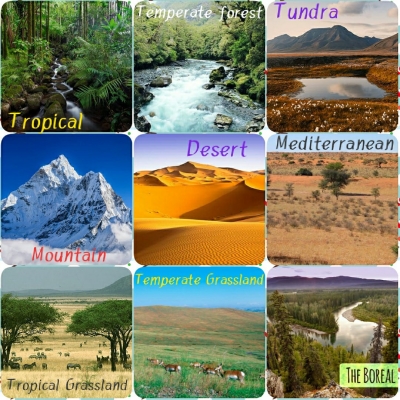
CLIMATE ZONES
Variations in the intensity of sunlight striking different parts of Earth drive global air movements and weather systems. Between them, these influences create a variety of climate zones, ranging from steamy tropical rainforests to the icy deserts of Antarctica. Most of these climate zones have a distinctive type of vegetation, which is the basis of a whole wildlife community, or biome.
- TROPICAL RAINFOREST
Intense sunshine near the Equator makes moisture evaporate and rise into the air to form huge storm clouds. These spill heavy, warm rain on the land below, fuelling the growth of dense rainforests.
- TEMPERATE FOREST
Temperate climates are neither very hot nor very cold. Near oceans, the mild, damp weather allows trees to grow well in summer, but many lose their leaves and stop growing in winter.
- POLAR AND TUNDRA
The Polar Regions get only weak sunlight in summer, and are dark all winter. They stay frozen all year, but in the north this icy region is surrounded by tundra, which thaws in summer allowing some plants to grow.
- MOUNTAIN
High mountain peaks are very cold, like Arctic tundra, and they have similar tough, low-growing vegetation. Lower mountain slopes are warmer, allowing trees to grow. The upper edge of this zone is called the tree line.
- DESERT
Some regions get so little rain that they are deserts. Many lie in a zone of hot, dry air near the tropics, but others are just too far from oceans. Some plants live in deserts, so they are not quite barren.
- MEDITERRANEAN
The dry shrublands that lie between the temperate zones and the main desert regions are named after the Mediterranean area where they are most common. The tough-leaved plants that live there can survive drying out in the hot summers.
- CLIMATE ZONES
The climate zones of the world form bands, with tropical rainforest near the Equator, most deserts in the subtropics, and boreal forest in the far north. Grasslands develop where it is too dry for trees.
- TROPICAL GRASSLAND
Tropical regions that are not within the zone of heavy rainfall are too hot and dry to support dense forest. They are seas of grass, often known as savannas, sometimes dotted with trees that can withstand long droughts.
- TEMPERATE GRASSLAND
Some temperate areas get little rainfall, usually because they lie at the hearts of great continents. Too dry for trees, they are naturally grassy steppes and prairies – although many are now farmland.
- BOREAL FOREST
To the south of the Arctic tundra, the northern continents support a band of dense forest. Most of the trees are conifers with stiff needle-like leaves that can survive the long, freezing winters.
Picture Credit : Google




